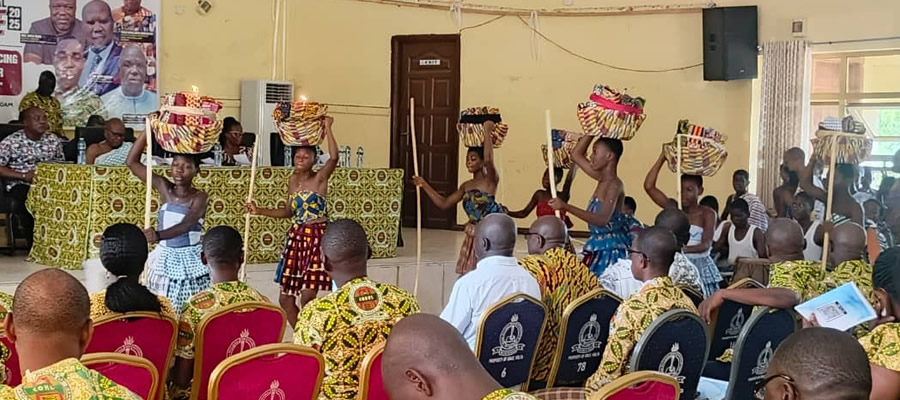

Investment and Business potentials
There are no major industrial enterprises in the Municipality although there are several small-scale industries in operation. Importantly, however, within the statutory planning area of Ho, two industrial zones have been demarcated. One is the Light Industrial Area, opposite the Volta Barracks.
Funding is being provided by the Assembly, in consultation with other stakeholders, for the extension of utility services such as water supply, electricity and telecommunication. The other is the Heavy Industrial Area at Titrinu on the Ho-Kpetoe road.With off-site infrastructure being provided on both sites, investors can take advantage of the position of the urban area closest to Ghana’s border with Togo, which provides unique opportunities to exploit vibrant markets in both countries.
Various areas in the district have already been earmarked as industrial free zones. Small-scale industrial activities receive credit support and investment advice from the National Board for Small-Scale Industries (NBSS), the Business Assistance Fund (BAF), and commercial banks.
Agriculture employs about two-thirds of the labour force in the Municipality and the government, including the Assembly itself, has provided suitable supporting services to facilitate high yield farm production and efficient produce marketing. Agricultural extension agents also advise farmers in crop production, livestock and fish farming and agro-forestry.
The Central Government and the Assembly have provided further support through the Agricultural Sector Improvement Programme ASIP, Employment, Income and Productivity Generative Activities, which involves purchases of tractors and ploughs, as well as credit to agriculture based activities, and the Youth in the Agriculture Programme, implemented with the funding of 10 separate groups in the Municipality.
The Municipality is an important producer of maize and cassava. Other crops of significant importance are yams, plantain, banana, citrus, rice, mangoes and avocado pear. Non-traditional crops like pineapple are important in Sokode Akrofu and Abutia areas. Sugar cane is grown in Tsawoenu and Ziope areas, while Adaklu area is also singularly well known for its honey production.
Investors would do well to set up production in these commodities, because productivity per hectare is outstandingly high and markets for them are vibrant, both in Ghana and abroad. The Ho Municipal Assembly, in its strategic plan for housing development, has already acquired over 680 hectares of land for estate development at Sokode Lokoe as the gateway to Ho, to complement the low housing stock in the Municipality.
The rich and enormous clay deposit on the Ho-Aflao road and other areas, such as Lume Akuetey, could again be exploited as good link – ups in the housing sector. Prospective estate developers, as well as individuals, are being encouraged to invest in this sector with the great enabling opportunities offered by th Municipal Assembly.
Housing supply has not kept pace with demand, especially in the capital. Estate development such as the SSNIT Flats at Ho, the VORADEP Village Housing under the Ministry of Agriculture and the low-cost housing estates at Tsito, Sokode, Kpetoes, Akuetey and Kpedze are all heavily patronised, but there is plenty of demand for housing yet unmet.
Micro/Municipal Economy
The economy of the Ho Municipality is not particularly buoyant even though the potentials are there to be exploited. The formal sector of the economy is made up mainly of employment in the Public Service, private construction companies, and a few large trading companies (like Areeba mainly located in Ho, the Municipal capital and the other urban areas of Kpedze and Tsito) there are also petty traders and few large scale traders. Other economic activities in these areas are subsistence farming, animal rearing, artisanry and vocations such as hairdressing and dressmaking.
The major economic activities in the rural areas of the Municipality where about 63% of the people live are subsistence farming and animal rearing. Other activities of any significance are stone and sand winning at Akrofu, Sokode, Klefe and Bame.
A striking feature of the economy of the Municipality is the low level of Investment, that is, total absence of large scale manufacturing industries and the limited number of service industries. Unemployment rate is there fore high, at about 11%. The absence of large-scale industries leading to high unemployment rate, adversely affects income levels in the urban areas. The subsistence nature of farms in the rural arrears coupled with the low rate of adoption of modern technology also results in low agricultural productivity, and hence, low incomes in the rural areas.
Since the economic activities undertaken in the urban areas yield higher returns than in the rural areas, income distribution in the Municipality is skewed towards those living in the urban areas of the Municipality.
Municipal Finance
- Revenue Generation The generally low levels of income in the Municipality affect the levels of internal revenue generation by the Municipal Assembly, since this mainly constitutes levies and rates collected from the people.
Locally generated revenue has therefore averaged only about 34% of the total revenue generated by the Assembly in a year. The record below shows the position: As a result of the low internally generated revenue of the Assembly, it depends heavily on government Grants, especially the District Assembly Common Fund for Development activities. Unfortunately, the Common Fund is inadequate and its release is irregular. Implementation of Development Programmes is, therefore, hampered in the Municipality.
Assembly Revenue Projections
The Assembly’s total revenue is, however growing at an rate of 30% per annum. Based on this and what is expected from donor sources, especially the European Union, revenue projection, for the plan period are as follows:
Financial Management in the Municipal Assembly
In a bid to improve local revenue generation, the Assembly re-trained and motivated its revenue collectors in 2005 to collect revenue from the Ho Central Market as well as the Central Lorry Park. Since then collection at the lorry park jumped from an average of 17,000,000.00 cedis per month to an average of 35,000,000 cedis per month, and collection in the market jumped from 1.5 m cedis to 3.0m cedis per market day.
Matching revenue with expenditure has been a difficult issue for the Municipal Assembly for some time now, as actual expenditure invariably exceeds the budgeted. The situation is caused mainly by price instability in the country. However, the Assembly is making every effort to bring expenditure in line with the budget and for that matter, revenue particularly, in the high expenditure areas of fuel consumption, utilities, stationery and entertainment of official guests.
With the support of the DSDA II Programme, Management Staff of the assembly have been given refresher courses on Internal Control Measures to sharpen their knowledge and skills for the prudent disbursement of the Assembly’s funds in accordance with laid down financial regulations. The Assembly also prepares its Common Fund Budget in strict compliance with the guidelines and therefore does not encounter any difficulty in getting it approved by the Regional Co-ordinating Council. With the assistance of the Audit service, the payrolls of the assembly and its departments have been checked thoroughly with the view to detecting and eliminating ghost names from them. The Assembly awards contracts in strict compliance with the procurement law. Efforts to Reduce Food Induced Inflation in the Municipality.
The Assembly bought two Massey Ferguson tractors in 1998 to assist farmers in the Municipality to increase food production. It also gives poverty alleviation loans to farmers during the farming season, all in an attempt to improve food production and storage to help control food induced inflation in the Municipality. So far, the Assembly has disbursed an amount of 900,000.000.00 cedis by way of loans to farmers and other economic groups from the poverty alleviation fund.
The recovery rate is, however, very low, that is, 18% and this threatens the revolving nature of the scheme as well as threatens the prospects of future loan schemes in the Municipality. To solve the problem of low rate of loan recovery, the Assembly has with effect from 2006 directed its poverty alleviation fund to the Youth Employment Programme.
Private Sector Competitiveness
- General Low Yields of Crops caused by: •S Small farm sizes ¦S Reliance on rain-fed agriculture •S Inadequate Agricultural infrastructure S High cost of agric inputs S Inadequate of credit facilities •S Low extension staff-farmer ratio S Inappropriate land tenure system.
- Post Harvest Losses Caused By: ¦S Inadequate access roads to hinterlands S Absence of cottage industries for vegetable processing S Lack of storage facilities •S Lack of markets for produce, especially during bumper harvest periods.
- Low Yields of Livestock Caused By: J Dependence on local breeds of small ruminants S Absence of aqua culture
- Land Litigation
- Unreliable Power Supply
- High Unemployment Rate
- Low yields from tourism
- Undeveloped tourism potentials
Date Created : 11/20/2017 5:46:53 AM












 facebook
facebook
 twitter
twitter
 Youtube
Youtube
 +233 593 831 280
+233 593 831 280 0800 430 430
0800 430 430 GPS: GE-231-4383
GPS: GE-231-4383 info@ghanadistricts.com
info@ghanadistricts.com Box GP1044, Accra, Ghana
Box GP1044, Accra, Ghana